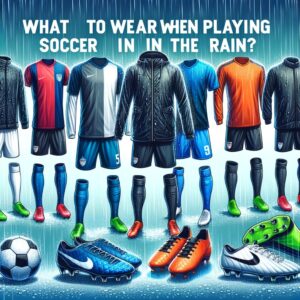As someone who has spent countless hours on the soccer field, I’ve learned that playing soccer in the rain is not just a challenge, it’s an adventure. The rain adds a layer of complexity, transforming a familiar game into an unpredictable and exciting journey. Every player, whether a beginner or an experienced veteran, finds a unique kind of fun in these wet conditions. The key is to change your mindset and embrace the rain’s impact on the game.
When the skies open up, the ball becomes more elusive, requiring refined control and a heightened sense of awareness. The slippery terrain increases the risk of injury, but with the right gear and style of play, you can stay safe and enjoy the game. I always advise players to adjust their techniques and be prepared for the extra challenges.
It’s about using tips to improve your game – like shorter passes and more controlled movements. Remember, a rainy match tests your adaptability and resilience, but with the right approach, it can be incredibly rewarding.
Importance of Playing Soccer in the Rain
Playing soccer in the rain is more than just a game; it’s an invaluable experience for any soccer player. It presents a unique opportunity to test and enhance your skills under different conditions. On a wet field, the ball skips unpredictably, faster across the surface, and stops abruptly in puddles. This requires players to be more precise with their touches and passes. You learn to adapt and adjust your strategies to the whims of Mother Nature. This unpredictability is not just a challenge; it’s a benefit that fosters mental toughness.
The unpredictability can be frustrating at times, as the ball may not always behave as expected. However, pushing through these challenges builds a stronger mindset and makes you more resilient. There’s something undeniably thrilling about mastering these conditions, turning potential obstacles into opportunities for growth.
Young players, especially kids, often love the thrill of playing in such exciting and unique circumstances. They revel in the participation even when the temp is cold, and the climates are less than ideal, turning a potentially chilly game into an adventure. With the proper gear, players can mitigate the risk of injuries, ensuring that the focus remains on the joy and learning that comes with playing in the rain.
What to Wear When Playing Soccer in the Rain?

When you’re playing soccer in the rain, the right gear can make all the difference. It’s not just about staying dry; it’s about maintaining comfort and performance in challenging conditions.
The Upper Body: Rain Jackets and Thermal Shirts
Start with a rain jacket. Choose one that’s lightweight, breathable, and provides maximum comfort. A good jacket keeps your upper body warm and dry, allowing you to move freely. For those night games, jackets with reflective strips are a smart choice. Underneath, a thermal shirt is crucial in cold weather. Opt for synthetic, water-resistant materials like polyester and spandex, ensuring sweat can escape and you don’t overheat.
Head and Neck Protection: Beanie Hats and Snoods
A waterproof beanie hat is essential for keeping your head warm and dry, particularly when the temperature is low. It prevents discomfort and potential illness from cold air and rain. For your neck, a snood can be a great addition. It’s optional, but it offers extra protection against the wind and rain, while still allowing flexibility and movement.
Lower Body Comfort: Waterproof Tights and Socks
Your legs need protection too. Waterproof tights under your shorts are a must, providing warmth while keeping you dry. Choose dark colors like black to conceal any mud stains. Socks are crucial – a wicking sock layer beneath a woolen sock helps keep your feet dry and warm, and prevents blisters. Make sure your soccer cleats can fit the extra layers of socks.
The Right Cleats and Shin Guards
Water-resistant soccer cleats are vital for playing in the rain. Soft-ground cleats are preferable for better grip and traction on wet surfaces. Protective gear like shin guards is also essential. They not only protect you from injuries but also ensure the safety of other players during aggressive tackles and slides.
By equipping yourself with the right attire and protective gear, you can turn a rainy soccer game into an enjoyable and safe sporting event, keeping the focus on the joy of the game rather than the discomfort of the weather.
Adapting to Wet Conditions when playing soccer in rain
By adapting your playing style to the rainy environment, you enhance your skills in unpredictable weather, making you a more versatile and skilled soccer player. This ability to adapt not only improves your game but also adds an exciting element to your soccer experience.
Mastering Movements and Footwork
When playing soccer in the rain, it’s crucial to adjust your footwork and movement to match the conditions. The rain makes the ground slick, turning the soccer field into a slippery surface.
To maintain balance, take shorter strides, keeping your feet closer to the ground. This technique helps prevent the risk of a slip or fall. Instead of sudden movements, opt for smooth, deliberate actions, which aid in better control of the ball.
Tactical Ball Control and Passing
In wet conditions, controlling the ball becomes more challenging. The wet surface can cause the ball to slow down or skip unexpectedly. Therefore, when passing, use more power to ensure the ball reaches its intended target. Keeping the ball close to your feet helps prevent it from slipping away.
For more accurate passes, use the inside of your foot and focus on short, accurate strokes. Remember, a ball in the air tends to skip forward quicker as it approaches the ground, so be ready to trap it efficiently.
Strategies for Shooting and Scoring
Shooting and scoring goals in the rain can be particularly difficult. The key is to adjust the power of your shot. Aim for the corners of the goal, making it harder for the goalkeeper to save the ball. During penalty kicks, take a shorter run-up to minimize the chance of slipping. This adjustment in your approach can significantly increase your chances of scoring, even under challenging conditions.
Safety Tips for Playing in the Rain
When playing soccer in the rain, it’s crucial to prioritize safety along with the fun of the game. Here are some key tips to keep in mind:
- It’s essential to have cleats that provide good traction to prevent slipping. Also, your clothing should keep you warm and dry. A quality rain jacket and waterproof pants are indispensable.
- Before you start playing, take time to inspect the field. Look out for hazards like puddles or uneven surfaces. Avoid playing in areas with standing water as it increases the risk of injury.
- Despite the wet environment, don’t forget to drink water before, during, and after the game. Rain can be deceiving, making you less aware of your body’s hydration needs.
- Be aware of the signs of hypothermia, which can occur in cold, wet conditions. Symptoms to watch out for include shivering, fatigue, confusion, and dizziness. If you experience these, it’s important to warm up and, if necessary, seek medical help.
By following these safety measures, you can enjoy playing soccer in the rain while minimizing the risks associated with wet and slippery conditions.
Drying Cleats after Playing in the Rain
After a game or training session in the rain, it’s crucial to dry your cleats quickly and properly to maintain their condition. The first step is to remove the laces and lay the cleats on a flat surface to air dry. This helps the moisture escape more efficiently.
If your cleats are exceptionally wet, stuff them with newspapers which are great at absorbing excess moisture. Then, position your shoes in front of a fan set on high. This will speed up the drying process significantly.
It’s important to check your cleats regularly for dryness. Make sure to rotate them to ensure both the outsides and insides are completely dry. However, avoid using a heater or hair dryer, as these can damage the materials of your cleats, causing them to warp or shrink.
In addition to drying, it’s equally important to clean your cleats after playing in the rain. Proper maintenance not only prevents damage but also helps to prolong the lifespan of your soccer gear.
Is Playing in the Rain Dangerous?
While playing soccer in the rain isn’t inherently dangerous, it does come with its own set of risks that require precautions for safety. The main concern is the increased risk of slipping and falling on wet grass or artificial turf, which can be quite slippery. Not maintaining proper footing can lead to sprains, strains, or even more serious injuries like broken bones or head trauma. Therefore, it’s essential to be cautious and aware of these potential hazards.
Another significant risk to consider in such conditions is the potential for hypothermia, especially in colder regions like New England. Getting cold and wet can lead to a dangerous drop in body temperature. To counter this, being properly dressed for the weather is key. Dressing in layers and having extra clothing to change into after the game is vital.
I recall a game last year in June, where it was rainy and around 20 degrees. My son was playing, and his body became so tensed, he could barely move his legs or arms until he had the chance to warm up on the bench after being subbed off. This highlights the importance of extra preparation and caution, ensuring that while we enjoy the game, we also protect ourselves and others from the risk of injury.
Tricks you Should Use to Play Soccer in the Rain
Playing soccer in the rain requires adapting your style and technique to the wet conditions.
- Adapting Your Playing Style: In rainy conditions, altering your approach to the game is key. Emphasize direct play; on a flooded pitch, long, intricate passing becomes less effective. Passes should be more vertical, propelling the ball forward rapidly towards the goal. During dribbling, make harder touches to prevent the ball from getting stuck in puddles, thereby maintaining possession.
- Shooting and Defensive Strategies: When it comes to shooting, especially low shots, the ball can bounce unpredictably on the wet field, often catching goalkeepers off guard. This can be an attacker’s Defensively, use tackles more freely. The reduced friction on wet surfaces makes slide tackling less risky, especially on artificial turf.
- Choosing the Right Gear: Selecting appropriate gear is crucial. SG boots with metal studs provide better traction and stability on softer grounds. While grippy boots and soccer balls with textured surfaces can offer better control, be cautious about overspending on expensive technologies with minimal difference in performance.
- Safety and Protection: Always prioritize safety. Wear quality shin guards and ensure all protective gear is secure. The chances of being hit or injured increase in slippery conditions. Also, keep an extra pair of socks and clothing in your bag for a quick change post-game, to stay warm and dry.
Adhering to these strategies not only enhances your performance in wet conditions but also helps maintain safety and enjoyment of the game, regardless of the weather.
Conclusion
Playing soccer in the rain presents unique challenges and opportunities. By adapting your playing style, selecting the right gear, and emphasizing safety and protection, you can turn a rainy day into an advantageous and enjoyable soccer experience.
Whether it’s mastering direct plays, utilizing tactical shooting, or choosing the most effective gear, each aspect contributes to your overall performance and enjoyment of the game. Rainy conditions test a player’s adaptability and skill, making every match in the rain a memorable and enriching part of your soccer journey.
Frequently Asked Questions
How do you stay dry during a rainy soccer game?
To stay dry during a rainy soccer game, wear waterproof gear like a rain jacket, waterproof pants, and water-resistant cleats. Using additional items like a waterproof beanie or a snood can also help keep you dry.
What to do after playing soccer in the rain?
After playing soccer in the rain, change into dry clothes as soon as possible. Dry off your gear, especially your cleats and shin guards, and warm up your body if you feel cold. Drinking warm fluids can also help.
Is football in the rain good?
Playing football in the rain can be good as it challenges players to adapt their skills and strategy to different conditions. It can improve ball control, passing accuracy, and mental toughness.
What is too wet for soccer?
A soccer field is too wet for play when there are large puddles or standing water on the pitch, as these conditions can increase the risk of injury and significantly alter the playability of the game.
How do you not get sick after soccer in the rain?
To avoid getting sick after playing soccer in the rain, change into warm, dry clothing immediately after the game. Keep yourself warm and hydrated, and if you feel chilled, take a warm shower or drink warm fluids to raise your body temperature.

